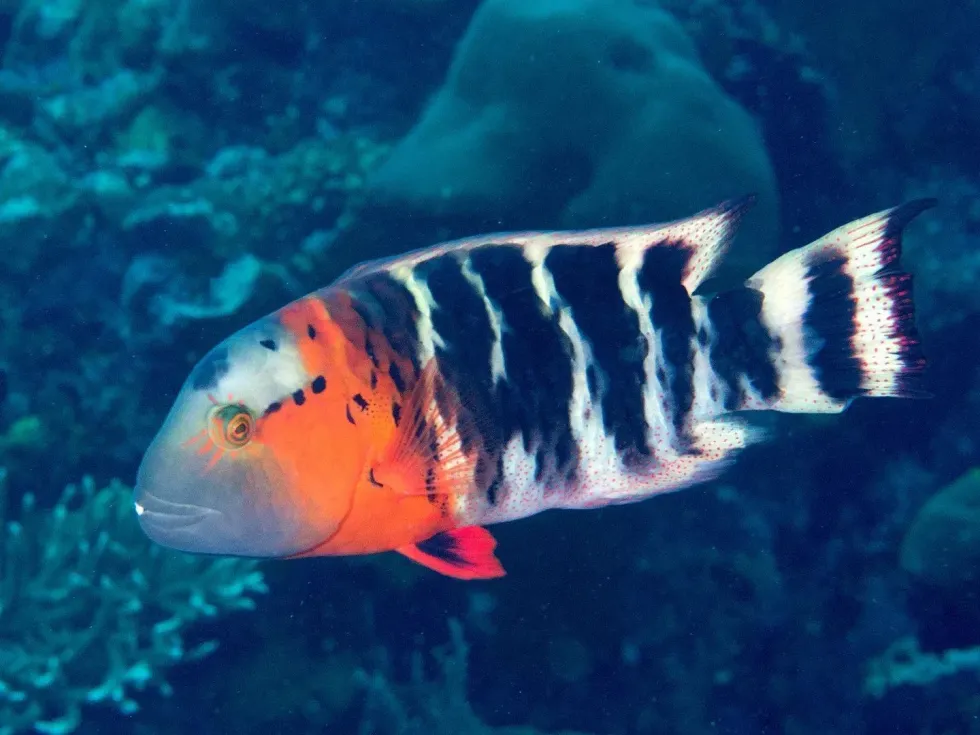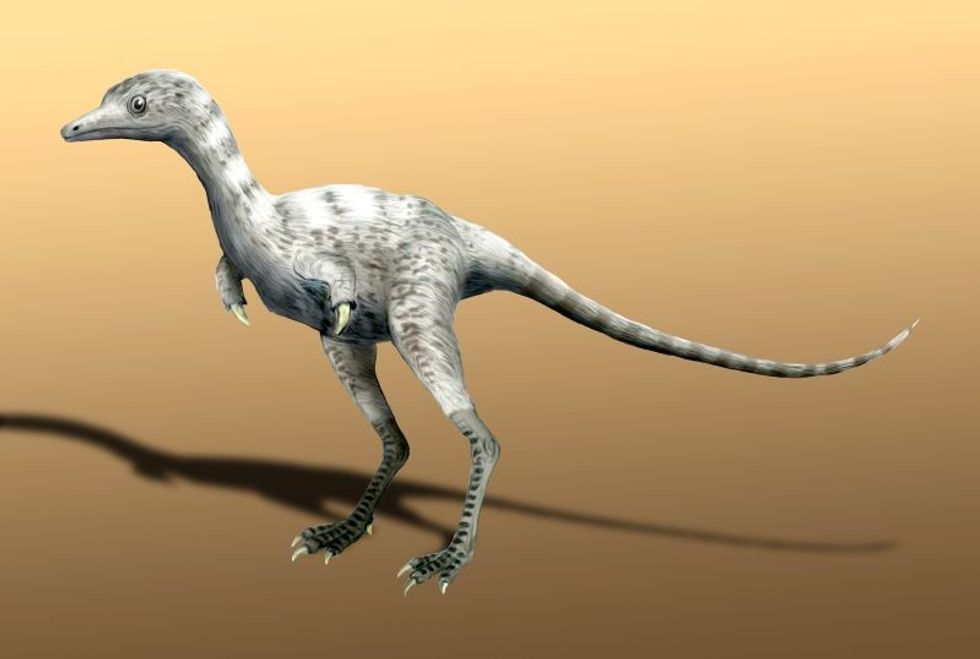The Cheilinus fasciatus is a beautiful marine species with its native distribution in the western Pacific and the Indian Ocean. Its range extends from the eastern coast of Africa all the way to Samoa, Micronesia, and Tonga; north till the Ryukyu Islands of Japan, and south to Queensland in Australia.
This Cheilinus genus species loves feeding on marine invertebrates, crustaceans, and mollusks. This member of the Labridae family has a very strong upper and lower jaw infused with strong incisors to cut through their prey.
They are often found swimming near reefs and sponges. They usually do not swim below 131 ft (40 m) depth. This is one of the best species to be kept in the aquarium.
For more relatable content, check out these humphead wrasse facts and guppy facts for kids.
Cheilinus Fasciatus Interesting Facts
What type of animal is a Cheilinus fasciatus?
The red-breasted wrasse (Cheilinus fasciatus) is a type of wrasse
What class of animal does a Cheilinus fasciatus belong to?
The red-breasted wrasse belongs to the class of fish.
How many Cheilinus fasciatus are there in the world?
We are not aware of the total population of the Maori wrasse as it has not been recorded yet.
Where does a Cheilinus fasciatus live?
This beautiful fish is found native to the western Pacific and the Indian Ocean. Around Australia, this species has been spotted on the Great Barrier Reef, islands of Queensland, and even off north-western parts of Western Australia.
Its distribution extends to countries like Madagascar, Mozambique, Tanzania, Kenya, and in the Arabian and Red seas. Furthermore, this beautiful fish has its range extending to the Maldives, Mauritius, Seychelles, India, Sri Lanka, Malaysia, Thailand, Indonesia, New Guinea, Philippines, Taiwan, China, Japan, Samoa, Micronesia, and even Tonga.
What is a Cheilinus fasciatus's habitat?
This fish is found in tropical marine habitats. They prefer seaward reefs and lagoons with a good mix of coral, sand, and rubble. They are usually found at depths within the range of 13.12-196.85 ft (4-60 m). However, they are rarely found below the depth of 131 ft (40 m).
Who does Cheilinus fasciatus live with?
Wrasses are actually solitary beings, known to live in loose groups.
How long does a Cheilinus fasciatus live?
Generally, all wrasse species have a lifespan between 3-30 years. If kept in any aquarium, they usually survive for only 5 years.
How do they reproduce?
Spawning in these fishes occurs in groups. It usually takes place in the warm afternoons in tropical shallow waters. Males patrol the territory, taking over the protection duties of the eggs. The entire spawning ritual takes about three hours.
The larval stage developments take place in the current. This stage lasts for about 26 days. Young wrasses are much different from the adults in terms of appearance. The young wrasse has a longer snout, the red-orange speckle is absent and they have fewer white bands.
What is their conservation status?
The conservation status of the red-breasted wrasse (Cheilinus fasciatus) is 'Least Concern'.
Cheilinus Fasciatus Fun Facts
What do Cheilinus fasciatus look like?
The redbreasted wrasse has a greenish-blue head. This head continues into a colorful wide body that begins with a dark orange-red band.
This is followed by a band of six or seven black-white vertical stripes. Fishes in their terminal phase have a deeper red band and a slightly convex forehead when compared to juvenile wrasses or fishes in their initial phases.
The pelvic fins are short. The pectoral fins have two unbranched with 10 branched rays. The region surrounding the pectoral fin is in shades of yellow to orange. The dorsal and anal fins point out posteriorly. There is a small orange area present behind the nape and eye leading to the pectoral fin base.
The fish has a total of nine dorsal spines and 10 dorsal soft rays. It also has three anal spines with eight soft anal rays. The body is moderately deep. The anterior snout tip forms an acute angle.
There are two strong canines present in the upper jaw. There are short orange lines radiating outwards from the eye. The scales in front of the dorsal fin extend forwards, ending at the eye’s anterior portion.
The lower and upper rays form elongated lobes in the larger individuals. There is a lateral line on the body which is interrupted below the posterior side of the dorsal fin base. This line has about 22-23 pored scales that reach onto the bases of both the dorsal and anal fins.
Juveniles have rounded caudal fins. They have a slight brown tint on their bodies with about five white bars. All bars except the second one extend to the dorsal as well as anal fins. The first bar is the broadest and brightest and is placed somewhere below the third dorsal-fin spine. Subadults and females have similar patterns to juveniles.

How cute are they?
We love how beautiful the redbreasted wrasse look! They have beautiful patterns on their body which makes them cute.
How do they communicate?
Fishes are known to communicate with electrical pulses and movements.
How big is a Cheilinus fasciatus?
This wrasse species can grow up to a maximum body length of 16 in (40 cm).
This body length equals 10 times the length of the golden tetra.
How fast can a Cheilinus fasciatus swim?
Sorry, we are not aware of how fast the Maori wrasse swims.
How much does a Cheilinus fasciatus weigh?
Oops, we do not know the weight of the redbreasted wrasse.
What are the male and female names of the species?
Male and female Cheilinus Fasciatus fishes have no specific names.
What would you call a baby Cheilinus fasciatus?
Generally, a baby fish goes by the name fry.
What do they eat?
The Maori wrasse feeds on sea urchins, mollusks, crustaceans like shrimp and krill, and even hard-shelled invertebrates. Some of these invertebrates include worms, crayfish, scuds, and even sponges.
Are they dangerous?
No, this Indo-Pacific wrasse species of the Labridae family is not dangerous at all!
Would they make a good pet?
We absolutely love the idea of keeping the redbreasted wrasse as a pet in our freshwater aquarium!
Did you know...
Other synonyms of this species are Labrus enneacanthus, Sparus fasciatus, Sparus bandatus and Cheilinus quinquecinctus.
The specific name of this fish is derived from the Latin term 'fasciatus', which translates to 'banded'. This is in reference to the striped design of the fish's body.
Some species of wrasse include humphead wrasse, rockmover wrasse, leopard wrasse, and yellowhead wrasse.
Naming the Cheilinus fasciatus
This beautiful aquarium species of the Labridae family is known by many other names: the banded Maori, redbreasted wrasse, banded Maori wrasse, scarlet red-breasted Maori wrasse, and even the redbreasted Maori wrasse.
The term 'banded' refers to the presence of multiple white and black vertical bars on the body of this species.
The 'redbreasted/scarlet red' term refers to the red/dark orange hue on the breast of this species.
The Cheilinus fasciatus' compatibility
This aquarium species is a very shy one. They would adjust with any other non-aggressive fishes in the aquarium. Make sure to keep props resembling reefs, a nice bed of sand, and ruble as well. However, they prefer being by themselves.
Here at Kidadl, we have carefully created lots of interesting family-friendly animal facts for everyone to discover! For more relatable content, check out these koi facts and Siamese fighting fish facts pages.
You can even occupy yourself at home by coloring in one of our free printable tropical fish coloring pages.









